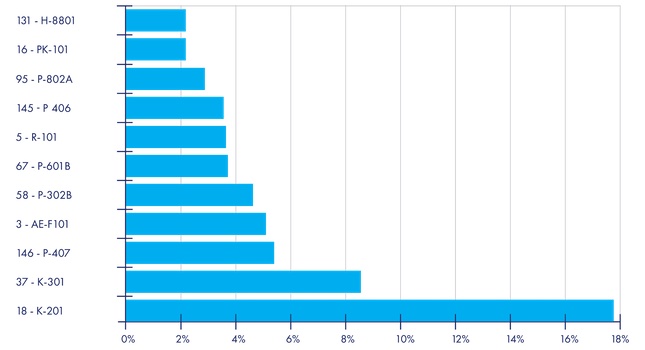It’s so much more than the latest buzzword – software as a service (SaaS) has substance, and it’s delivering.
It’s so much more than the latest buzzword — software as a service (SaaS) has substance, and it’s delivering. Consider the arena of business intelligence (BI). While traditional BI still has a place in strategic data analysis, it falls short when it comes to supporting operational performance improvement initiatives. True performance improvement requires more than what traditional BI offers.
A new breed of SaaS-based performance improvement solutions is helping plant managers to save money, boost productivity and increase efficiency. The “secret sauce?” First is the ability to look across a value stream — even when data resides outside the plant or the company. Second is embedded industry expertise and best practices.
One of the beauties of SaaS is the ease of implementation and deployment, meaning less strain on IT. Add to that the ability to integrate with existing processes and systems, handle real-time metrics and show cause-and-effect by linking operational metrics with financial outcomes, and you’ve got yourself a cost- and resource-effective option for making sense of your plant data.
Looking across the value stream
Today, business processes span across enterprise boundaries, meaning that key performance indicators (KPIs) reside both inside and outside the plant. While metrics such as on time in full shipments, OEE or quality reject rates/first time through can be found inside the plant, the majority of important metrics related to vendor quality, timeliness and ability to meet demand — such as reject reason (of goods returned from customers), vendor- and customer-reported on time in full delivery — reside outside the plant.
Since a significant amount of data is beyond plant boundaries, performance improvement — or “operational BI” — capabilities delivered in an SaaS model expose the true drivers of outcomes, which are absolutely critical for effective performance analysis.
The SaaS model is an excellent vehicle to gather data from, and then present specific information back to partners, your supply chain and even customers, without these users having to directly access information behind the company’s firewall. The SaaS model also lends itself to adding value in the form of aggregated benchmarks, best practices and behavior analysis that is impossible with traditional on-premise software.
Embedded industry expertise
With the right industry expertise and best practices integrated into an SaaS solution, users benefit from vertical industry, value stream and methodology knowledge, which can be leveraged as part of a greater performance improvement initiative.
For example, consider metrics that support continuous improvement such as Lean processes. The new breed of SaaS-based operational BI tools provide decision makers throughout the plant with embedded knowledge that provides targets or goals for each of the relevant metrics — such as material handling time, cycle time and changeover time — and guidance on recommended analysis and diagnosis to undertake if a metric is not meeting the target or is outside the “good” zone. The ease of configuration and flexibility of SaaS-based operational BI tools, combined with pre-defined metrics raises the standard for data access and data analysis throughout the plant, and delivers quick time-to-value.
Instant value across the board
With KPIs tailored specifically to each plant and each individual user, performance improvement can actually live up to its promise. Whether on the plant floor or in a corporate office, multiple knowledge workers need continuous access to timely, relevant business metrics for analysis and operational decision making.
The cost effectiveness of a subscription-based SaaS model makes it viable to support larger numbers of users — from the plant manager and quality manager to line controllers and the COO and CFO — whereas traditional approaches are typically focused on a small number of business analysts. With performance visualization and analysis that is intuitive and easy to use — accessible from a web browser no matter where users are located at the time they need information — companies can ensure their investment brings immediate value, with quick and widespread adoption.
By consolidating all relevant data into one easy-to-understand and easy-to-analyze view, operational BI solutions based on an SaaS model help users make quick, informed decisions that positively impact the operational productivity and efficiency of the plant.
| Author Information |
| Wayne Morris is CEO of myDIALS, a pioneer in SaaS-based operational performance management software. Morris previously served as CEO and managing director of Citect Corp., and chief marketing officer and senior vice president of corporate marketing for BMC Software Inc. |
Automation lab dedicated at NIU
The Northern Illinois University College of Engineering and Engineering Technology dedicated the AutomationDirect Laboratory on the university’s main campus in DeKalb, IL on Sept. 19. AutomationDirect, the lab’s sponsor, extended a gift of $100,000 spread over four years, which will also enable a named term professorship.
Promod Vohra, dean of the College of Engineering and Engineering Technology at NIU, expressed his gratitude for the gift and the AutomationDirect partnership. “The kind of trust they have put in us and the kind of opportunities this endeavor is going to provide to our students is going to be wonderful,” he said.
“As a dean, I’ve always felt that engineering colleges are meant to stimulate economic development,” Vohra continued. “Engineering schools have to promote innovation. That’s why they have to have the best possible laboratory environment for them to expand, explore and find new ways of doing things.
“I meet a lot of graduates from different schools; many of them are theoretical,” said Vohra. “But I think they’ve lost the practical edge in our country. And that’s what we want to give back to our students.” He said AutomationDirect’s gift will help them accomplish that.
Joan Welty, AutomationDirect’s director of marketing agrees. “I think we would all like to see the U.S. stay in the forefront of technology development — not only to help drive our economy, but also to help solve many issues that we’re facing in the world today,” she said.
Welty, who holds a bachelor’s degree in electrical engineering technology from NIU, also said her company feels that industry should take a more active role in encouraging and supporting young people in pursuing technical degrees, and while doing so, have access to the most current equipment.
Andrew Otieno will fill the role of AutomationDirect professor. He will supervise and maintain the lab. He also will facilitate the creation of programs to provide professional development training in the lab for engineers and technologists from local industries.



